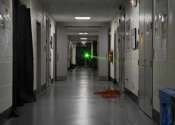Experiment demonstrates continuously operating optical fiber made of thin air
Researchers at the University of Maryland (UMD) have demonstrated a continuously operating optical fiber made of thin air.

Researchers at the University of Maryland (UMD) have demonstrated a continuously operating optical fiber made of thin air.
Optics & Photonics
May 3, 2023
0
374

It's not at every university that laser pulses powerful enough to burn paper and skin are sent blazing down a hallway. But that's what happened in UMD's Energy Research Facility, an unremarkable looking building on the northeast ...
Optics & Photonics
Jan 19, 2023
3
637

For the first time, physicists have built a two-dimensional experimental system that allows them to study the physical properties of materials that were theorized to exist only in four-dimensional space. An international ...
Quantum Physics
Jan 3, 2018
4
2554

MIT researchers have introduced a quantum computing architecture that can perform low-error quantum computations while also rapidly sharing quantum information between processors. The work represents a key advance toward ...
Quantum Physics
Jul 29, 2020
1
5089

Conventional computers store information in a bit, a fundamental unit of logic that can take a value of 0 or 1. Quantum computers rely on quantum bits, also known as a "qubits," as their fundamental building blocks. Bits ...
Quantum Physics
Sep 27, 2018
0
398

Reliably guiding and capturing optical waves is central to the functioning of various contemporary technologies, including communication and information processing systems. The most conventional approach to guide light waves ...

(PhysOrg.com) -- Researchers at Cornell University have developed a device called a "time lens" which is a silicon device for speeding up optical data. The basic components of this device are an optical-fiber coil, laser, ...

Researchers in the University of Minnesota's College of Science and Engineering have measured the twisting force, or torque, generated by light on a silicon chip. Their work holds promise for applications such as miniaturized ...
Optics & Photonics
Sep 26, 2016
2
1457

One of the challenges of optical microscopy is to continually increase the imaging power, or resolution. In the past three hundred odd years, scientists have been building ever-better microscopes. The limit, for a long time, ...
Optics & Photonics
May 14, 2020
0
235

A team of Columbia Engineering researchers, led by Applied Physics Assistant Professor Nanfang Yu, has invented a method to control light propagating in confined pathways, or waveguides, with high efficiency by using nano-antennas. ...
Nanophysics
Apr 17, 2017
1
1136